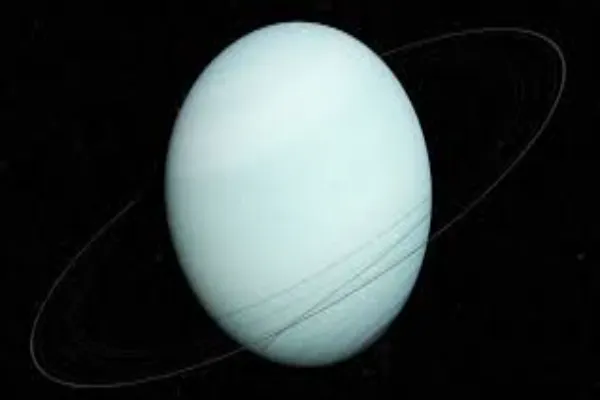10 Facts About Uranus, the Ice Giant
Exploring the Mysteries of the Ice Giant 10 Facts About Uranus
Uranus, the seventh planet from the Sun, is a distant and enigmatic ice giant that has long captivated astronomers and space enthusiasts. Discover the wonders of this unique celestial body through 10 facts about Uranus that contribute to the mystique of the planet.
1. Unusual Axial Tilt: Uranus has a distinctive feature that sets it apart from other planets—it rotates on its side. Unlike the majority of planets in our solar system, which spin with their axes roughly perpendicular to their orbital planes, Uranus rotates almost parallel to its orbit. This extreme axial tilt of about 98 degrees gives Uranus a peculiar and rolling motion as it orbits the Sun.
2. The Ice Giant: Uranus is classified as an ice giant, a designation that highlights its composition. While it contains a small rocky core, the majority of Uranus is composed of volatile substances like water, ammonia, and methane. These elements, existing in various forms, contribute to the planet’s unique coloration.
3. A Pale Blue Dot: Uranus displays a subtle bluish-green hue due to the presence of methane in its atmosphere. This muted coloration sets it apart from the predominantly reddish appearance of its gas giant counterparts, such as Jupiter and Saturn.
4. Rapid Rotation: Despite its peculiar axial tilt, Uranus experiences a surprisingly rapid rotation. A day on Uranus, measured by its rotation period, lasts only about 17.24 hours, making it one of the faster-spinning planets in our solar system.
5. Rings of Uranus: Uranus is encircled by a system of rings, although they are much fainter and less prominent than the iconic rings of Saturn. The first rings of Uranus were discovered in 1977, and additional rings were identified in subsequent observations, enhancing our understanding of the planet’s ring system.
6. Voyager’s Visit: The only spacecraft to have visited Uranus is NASA’s Voyager 2. In 1986, Voyager 2 conducted a flyby, providing the first close-up images and scientific data about the planet and its system of moons.
7. Moons Galore: Uranus boasts a diverse array of moons, with at least 27 confirmed natural satellites. Among these, Titania and Oberon stand out as the largest and most prominent moons in orbit around the ice giant.
8. Seasonal Extremes: Uranus experiences extreme seasonal variations due to its axial tilt. During its summer and winter solstices, one pole is exposed to sunlight for an extended period, while the other remains in darkness. These prolonged seasons contribute to Uranus’ unique atmospheric dynamics.
9. The Great Dark Spot: Similar to Jupiter’s Great Red Spot, Uranus has its own atmospheric feature known as the Great Dark Spot. However, this storm system observed in the 1986 Voyager flyby has since disappeared, raising questions about the dynamic nature of Uranus’ atmosphere.
10. Mysteries of Magnetic Fields: Uranus possesses a highly tilted magnetic field, which is believed to be generated by an asymmetrical arrangement of magnetic and rotational axes. The mysteries surrounding Uranus’ magnetic field continue to intrigue scientists, inviting further exploration and study.
10 Facts About Uranus: Cosmic Secrets of the Sideways Planet

Uranus, the seventh planet from the Sun, unfolds a tapestry of peculiarities and mysteries that distinguish it in our cosmic neighborhood. One of the most distinctive features of Uranus is its extreme axial tilt, rotating almost parallel to its orbit.
This peculiar tilt, at about 98 degrees, sets Uranus apart from the other planets and results in a peculiar rolling motion as it completes its orbit around the Sun. This unusual axial tilt, coupled with its rapid rotation of approximately 17.24 hours, creates a unique dynamic in Uranus’ atmosphere and contributes to the planet’s enigmatic nature.
The icy composition of Uranus classifies it as an ice giant, with volatile substances like water, ammonia, and methane dominating its structure. This composition gives Uranus its subtle bluish-green color, a hue that contrasts with the more vibrant colors of its gas giant counterparts.
Voyager 2’s 1986 flyby provided a closer look at Uranus and its intricate system of rings and moons, further unraveling the mysteries of this distant planet. With its unique characteristics and ongoing mysteries, Uranus remains an object of fascination for astronomers, inviting continued exploration and study to unveil the secrets hidden within its icy depths.
Uranus, with its celestial oddities and captivating features, remains a source of fascination for astronomers. As we continue to study and explore the 10 facts about Uranus, the ice giant, each revelation adds to the rich tapestry of knowledge about the diverse and dynamic planets that populate our solar system.